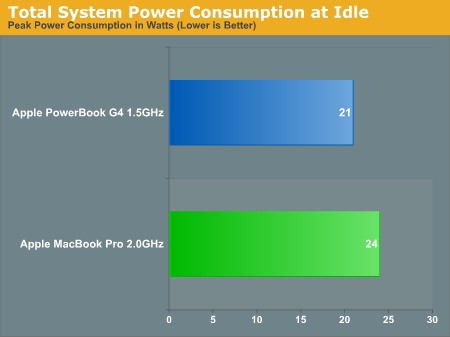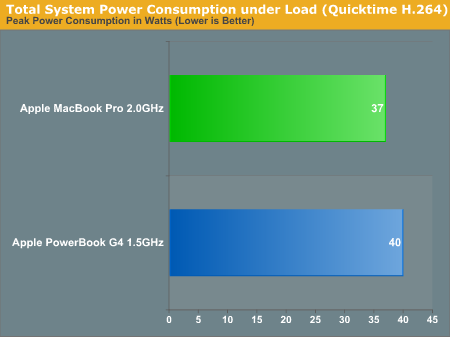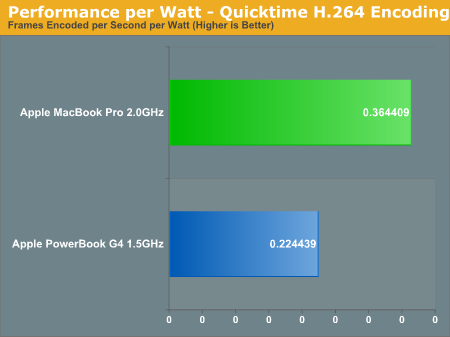Apple's MacBook Pro: Using it as a Mac and a PC
by Anand Lal Shimpi on April 13, 2006 12:00 AM EST- Posted in
- Mac
Power Consumption and Performance per Watt
Compared to the G5, Intel's Core Duo has no problems offering lower power consumption, but what about when pitted against the G4? The whole reason the G4 was kept in Apple's notebook lines was because of its low power consumption; while the Core Duo can easily be a better mobile CPU than the power hungry desktop G5, how does it compare to an already low power G4?
First off, I measured idle power consumption of the entire notebook at the wall outlet. The battery was removed from both notebooks so we're only testing the power consumption of the computer + display.

At idle, the PowerBook G4 running at 1.5GHz manages to come in at 21W total system power consumption, a full 3 Watts lower than the Core Duo 2.0GHz system. The number of variables between the two systems are really too many to count, thus making it difficult to declare this a clear victory for the G4 processor over Core Duo, but it does mean that the older PowerBook G4 notebooks consumes slightly less power as a whole at idle than the newer MacBook Pros.
Next, we ran our QuickTime H.264 encode test and looked at peak power consumption under full CPU load. Keep in mind that QuickTime's H.264 encoder is multi-threaded so both cores are under full load in the MacBook Pro:

Under full load the PowerBook G4 jumps up to 40W while the MacBook Pro falls 3W short and peaks at 37W, giving us a role reversal. It looks like although the older G4 systems consume less power at idle, the MacBook Pro is greener under full load. Of course low power consumption itself is meaningless if you don't have the performance to back it up (remember Transmeta?). Now let's look at the performance per Watt in the previous test.
What I did for this graph was take the average frame rate during the H.264 encode task and divided it by the peak power consumption during the test thus giving us performance measured in frames encoded per second, per Watt.

Using QuickTime's H.264 encoder as our benchmark, the new MacBook Pro offers around 62% better performance per Watt than the previous PowerMac G4. For a notebook, that sort of increase in performance per watt is extremely important.
Interestingly enough, despite the relatively similar power consumption characteristics the new MacBook Pro uses a noticeably larger AC adapter than the PowerMac G4 rated at 85W instead of 65W.










52 Comments
View All Comments
Calin - Thursday, April 13, 2006 - link
This could be thanks to slower drivers in BootCamp Windows XP, or slower hard drive access/speed. Everything else is a disadvantage for VM: one more level of indirection in disk access, less memory, running the OS X behind the VM.Could you do some disk speed comparation between VM and native XP?
BigLan - Thursday, April 13, 2006 - link
I think it's going to be hard drive speed throwing off the benchmarks. The BootCamp partition is going to be at the outer edge of the disk, with much slower speeds than the VM client virtual drive which is on the faster Apple partition.I'm not sure if it's possible to assign the entire HD to a windows partition using Bootcamp, but that's about the only way i can think of to level the playing field.
Calin - Friday, April 14, 2006 - link
To nitpick, it would be at the center of the hard drive, not at the outer edge :) (ok, based on sector numbers, which starts at the edge).Near the "end" of the hard drive, the transfer speed is reduced (there are fewer bytes on a full circle).
jimmy43 - Thursday, April 13, 2006 - link
Excellent Review. This may be my first laptop purchase, seems to have everything I could possibly want.monsoon - Thursday, April 13, 2006 - link
Hello Anand,...i'm waiting for Parallels to finalize their VT release and maybe Merom Macs too...
I was wondering if the ONE CORE only VT tech is to be the final result of their virtualization software or just a middle-step.
Seems to me it's rather poor a solution ( ok, it's the best out there for now ) to use a dual-core computer to run both OS on a single core
=/
Better would be smart distribution of tasks to the CPU depending on which OS is actually under load...
...any thoughts / info on that ?
Thanks for your nice review !=)
plinden - Thursday, April 13, 2006 - link
Looking at CPU load while running Parallels VM, I see the load spread evenly over both processors (usually < 10% total CPU except at boot, when it reaches 150% CPU). It's just that the VM itself sees itself as running on a single processor.
shuttleboi - Thursday, April 13, 2006 - link
I've read that the ATI X1600 in the Mac can run games well, but only IF you overclock the GPU. I can't imagine the Mac getting any hotter than it already supposedly is, and the idea of overclocking an already hot laptop is not appealing.JoKeRr - Thursday, April 13, 2006 - link
Overall I enjoyed it.Would have been nice to see a comparison of screen brightness, as apple claimed 67% brighter!
And also, the slowness in windows, could it be related to chipset driver stuff?? And what's the gaming experience so far like?? Would it be similar to a desktop 6600 or 6600gt??
Thank you.
rolls - Friday, April 14, 2006 - link
Very interesting numbers all round.35% improvement in iTunes when comparing a single core 1.5GHz 7447 with the old slow bus etc, and a new 33% faster dual core intel CPU. 50% improvement in H.264 encoding etc. These numbers suggest that had Apple stuck with Freescale and moved to e600 core based systems, performance figures could have been off the scale. If only...
JarredWalton - Thursday, April 13, 2006 - link
On paper the X1600 Pro desktop cards actually look pretty decent. 12 pipelines at 500 MHz, with 800 MHz RAM. I would have thought they would at least give the 6600GT a run for the money, given how X1800 compares to 7800. Amazingly (to me), the X1600 gets completely stomped by the 6600GT. What's worse, the cards I have can't even overclock worth a darn on the memory side - 800 is stock, and they get unstable at even minor changes. (Could be an issue with the overclocking tool, though?)Anyway, for now I would say X1600 Mobility is going to be somewhere in the realm of 6600 (non-GT) performance, maybe slightly faster. That means gaming is definitely possible, but you will want low-to-medium detail levels for any recent titles. Just a guess, of course, and Anand will have to run benches to get any final confirmation. Really, though, this laptop isn't intended as anything more than a light gaming solution.